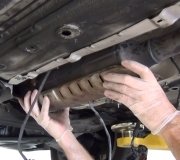Hi and thanks for using 2CarPros.
There are two pre catalytic converters on your vehicle and one three way. On the down pipe from the exhaust manifolds are the catalytic converters. The two pipes join together and then exhaust runs through the three way converter.
As far as the upper catalytic converters (pre catalytic converters) they bolt directly to the exhaust manifold. I will provide directions. I am going to start with the front. All attached pictures correlate with these directions.
FRONT EXHAUST MANIFOLD PIPE
REMOVAL
NOTICE: Do not apply grease or silicon products to the heated oxygen sensor. Do not alter the wiring in any way. The wires carry air reference to the sensor.
Picture 1
1. Remove the heated oxygen sensor electrical connector
CAUTION: MAKE SURE VEHICLE IS PROPERLY SUPPORTED AND SQUARELY POSITIONED ON HOIST.
2. Raise vehicle on hoist
3. Remove heated oxygen sensor.
Picture 2
4. Remove exhaust manifold pipe to exhaust manifold nuts.
Picture 3
5. Remove front exhaust manifold pipe to rear exhaust manifold pipe attachment bolts.
INSTALLATION
Picture 4
1. Position gasket on exhaust manifold pipe.
2. Position front exhaust manifold pipe into vehicle.
NOTICE: Do not tighten fasteners.
3. Install exhaust manifold pipe to exhaust manifold nuts.
Picture 5
4. Position gasket between front and rear exhaust manifold pipes
5. Install front exhaust manifold pipe to rear exhaust manifold pipe bolts and tighten
Torque:
Exhaust Manifold Pipe Bolts: 20 Nm (15 ft. Lbs.)
6. Tighten exhaust manifold pipe to exhaust manifold nuts
Torque:
Exhaust Manifold Pipe-to-Exhaust Manifold Nuts: 30 Nm (25 ft. Lbs.)
Picture 6
NOTICE: Always use a pickle-based anti-seized compound (Saturn P/N 21485279 or equivalent) on the threads of the oxygen sensor If the oxygen sensor is replaced, do not apply anti-seize to the new sensor. New sensors have anti-seize pre-applied. Never use silicon product; silicon products will cause damage to oxygen sensor.
7. Install the heated oxygen sensor
Torque:
Oxygen Sensors (Lower Exhaust Pipe): 45 Nm (33 ft. Lbs.)
8. Connect heated oxygen sensor harness connector
9. Lower vehicle from hoist
10. Start engine and check for exhaust leaks
_____________________________________
Here are the directions for the rear pre cat
REAR EXHAUST MANIFOLD PIPE
Picture 7
1. Remove exhaust manifold pipe heat shield.
Picture 8
NOTICE: Do not apply grease or silicon products to the heated oxygen sensor. Do not alter the wiring in any way. The wires carry air reference to the sensor.
2. Remove heated oxygen sensor electrical connector.
3. Remove heated oxygen sensor.
CAUTION: MAKE SURE VEHICLE IS PROPERLY SUPPORTED AND SQUARELY POSITIONED ON HOIST.
4. Raise vehicle on hoist.
Picture 9
5. Remove rear exhaust manifold pipe to exhaust manifold nuts
Picture 10
6. Remove rear exhaust manifold pipe to front exhaust manifold pipe attachment bolts.
Picture 11
7. Remove rear exhaust manifold pipe to resonator bolts.
8. Remove rear exhaust manifold pipe from vehicle.
INSTALLATION
NOTICE: Do not tighten fasteners at this time.
Picture 12
1. Install exhaust manifold pipe to exhaust manifold gasket, position pipe into vehicle.
2. Install rear exhaust manifold pipe to exhaust manifold nuts.
Picture 13
3. Position gasket and install front exhaust manifold pipe to rear exhaust manifold pipe bolts.
Picture 14
4. Position gasket and install exhaust manifold pipe to resonator bolts and tighten
Torque:
Exhaust Manifold Pipe Bolts: 20 Nm (15 ft. Lbs.)
5. Tighten exhaust manifold pipe to exhaust manifold nuts
Torque:
Exhaust Manifold Pipe-to-Exhaust Manifold Nuts: 30 Nm (25 ft. Lbs.)
6. Tighten rear exhaust manifold pipe to front exhaust manifold pipe bolts
Torque:
Exhaust Manifold Pipe Bolts: 20 Nm (15 ft. Lbs.)
Picture 15
7. Lower vehicle from hoist
NOTICE: Always use a pickle-based anti-seized compound Saturn PIN 21485279 (or equivalent) on the threads of the oxygen sensor. If the oxygen sensor is replaced, do not apply anti-seize to the new sensor. New sensors have anti-seize pre-applied. Never use silicon product; silicon products will cause damage to oxygen sensor.
8. Install heated oxygen sensor
Torque:
Oxygen Sensors (Lower Exhaust Pipe): 45 Nm (33 ft. Lbs.)
9. Connect heated oxygen sensor harness connector
Picture 16
10. Install exhaust manifold pipe heat shield
Torque:
Exhaust Manifold Pipe Heat Shield Bolts: 8 Nm (71 inch lbs.)
11. Start engine and check for exhaust leaks
_____________________
I hope this helps. The last picture shows the entire system. Let me know if you have other questions or need additional help.
Take care,
Joe
Images (Click to make bigger)
Sunday, January 27th, 2019 AT 8:25 PM





















